The Hydrating Emollient Creams Market is expected to record a valuation of USD 9,601.3 million in 2025 and USD 20,302.4 million in 2035, with an increase of USD 10,701.1 million, which equals a growth of 193% over the decade. The overall expansion represents a CAGR of 7.8% and a 2X increase in market size.
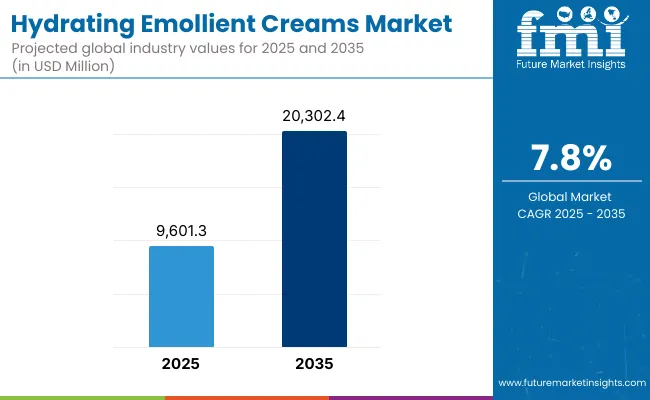
Hydrating Emollient Creams Market Key Takeaways
| Metric | Value |
|---|---|
| Hydrating Emollient Creams Market Estimated Value (2025E) | USD 9,601.3 million |
| Hydrating Emollient Creams Market Forecast Value (2035F) | USD 20,302.4 million |
| Forecast CAGR (2025 to 2035) | 7.8% |
During the first five-year period from 2025 to 2030, the market increases from USD 9,601.3 million to USD 13,961.7 million, adding USD 4,360.4 million, which accounts for 41% of the total decade growth. This phase records steady adoption of daily hydrating creams in pharmacy, e-commerce, and specialty retail channels, driven by rising demand for skin barrier repair and moisture retention solutions. Ceramides & fatty acids dominate this period as preferred emollient ingredients, catering to over 58% of formulations addressing chronic dryness and xerosis.
The second half from 2030 to 2035 contributes USD 6,340.7 million, equal to 59% of total growth, as the market jumps from USD 13,961.7 million to USD 20,302.4 million. This acceleration is powered by widespread consumer shift toward multi-functional creams with hydrating and anti-aging benefits, along with innovation in dermocosmetic repair balms and overnight moisture masks. Hyaluronic acid, squalane, and plant-based lipid complexes gain traction in next-generation formulas, while China, India, and Japan together account for the fastest growth with CAGRs above 10% during the forecast period.
From 2020 to 2024, the Hydrating Emollient Creams Market grew steadily, driven by the rising adoption of daily hydrating creams and ceramide-based formulations across pharmacies and online platforms. During this period, the competitive landscape was dominated by global skincare brands controlling nearly 70% of revenue, with leaders such as CeraVe, Eucerin, and Nivea focusing on barrier-repair and dermatologist-backed product lines.
Competitive differentiation relied on ingredient transparency, clinical validation, and dermatologist endorsement, while premium dermocosmetic repair balms emerged as niche yet fast-growing subcategories. Service-based or subscription-driven models had limited penetration, contributing less than 8-10% of total market value through online D2C sales.
Demand for Hydrating Emollient Creams is expected to expand to USD 9,601.3 million in 2025, and the revenue mix will shift further as advanced moisturizing technologies and hybrid formulations gain prominence. Traditional mass-market leaders face rising competition from clinical skincare brands and digital-native D2C entrants offering AI-based skin analysis, personalized hydration regimens, and sustainability-certified packaging.
Major global brands are pivoting to multi-active emulsions combining hyaluronic acid, polyols, and plant-based lipids to retain consumer loyalty. Emerging entrants specializing in microbiome-friendly, vegan, and refillable cream formats are gaining share. The competitive advantage is shifting from basic hydration claims toward scientifically supported skin-barrier restoration, ingredient innovation, and long-term dermal health positioning.
Advances in formulation science and dermocosmetic research have improved product efficacy and texture, allowing for more targeted hydration and barrier repair across diverse skin types. Daily hydrating creams have gained popularity due to their lightweight textures and compatibility with both sensitive and combination skin, making them a preferred choice for everyday use.
The rise of ceramide and hyaluronic acid-based formulations has contributed to enhanced moisture retention and long-term skin health. Industries such as dermocosmetics, retail skincare, and pharmaceutical personal care are driving demand for hydrating emollient creams that integrate dermatological validation with cosmetic appeal.
The expansion of pharmacy distribution networks and online D2C skincare channels has further fueled market growth. Innovations in bio-based emollients, microbiome-safe actives, and multi-layer moisture delivery systems are expected to open new application areas. Segment growth is expected to be led by daily hydrating creams in product categories and ceramide & fatty acid-based formulations in ingredient segments due to their proven skin-barrier support and adaptability to varying climate conditions.
The Hydrating Emollient Creams Market is segmented by product type, key ingredients, skin concern, channel, end user, and region. By product type, the market covers daily hydrating creams, rich barrier creams, dermocosmetic repair balms, and overnight moisture masks, which represent the primary formulations addressing varying levels of skin dryness and sensitivity.
By key ingredients, the segmentation includes glycerin and polyols, ceramides and fatty acids, shea/cocoa butters, squalane and esters, and hyaluronic acid, each serving distinct hydration and barrier-repair functions. Based on skin concern, categories include chronic dryness/xerosis, sensitive or reactive skin, seasonal dehydration, and aging-related dryness, reflecting diversified consumer needs across age and skin conditions.
Distribution channels comprise pharmacies and drugstores, e-commerce, supermarkets and hypermarkets, and specialty beauty retail, enabling broad accessibility through both offline and digital touchpoints. The end-user segmentation covers women, men, unisex family care, and senior skin, addressing demographic-specific skincare demands.
Regionally, the market scope spans North America, Europe, East Asia, South Asia & Pacific, Latin America, and the Middle East & Africa, with leading growth expected in China, India, and Japan driven by urbanization, expanding skincare awareness, and rising adoption of premium dermocosmetic products.
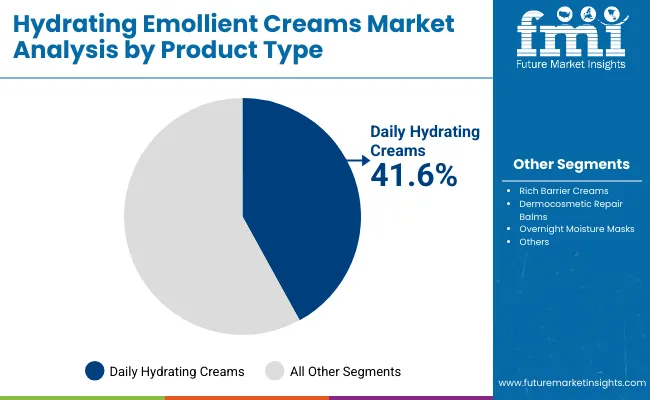
| Product Type | Value Share % 2025 |
|---|---|
| Daily hydrating creams | 41.6% |
| Others | 58.4% |
The daily hydrating creams segment is projected to contribute 41.6% of the Hydrating Emollient Creams Market revenue in 2025, maintaining its lead as the dominant product category. This is driven by consistent consumer demand for lightweight, fast-absorbing moisturizers suitable for daily use across various skin types. Consumers increasingly prefer these formulations for their hydration efficiency, non-greasy finish, and dermatologist-tested claims.
The segment’s growth is further reinforced by innovations in long-lasting hydration systems that combine polyols, ceramides, and humectant complexes for improved barrier restoration. As e-commerce penetration expands and consumers seek multifunctional skincare, daily hydrating creams are expected to remain the backbone of the Hydrating Emollient Creams Market.
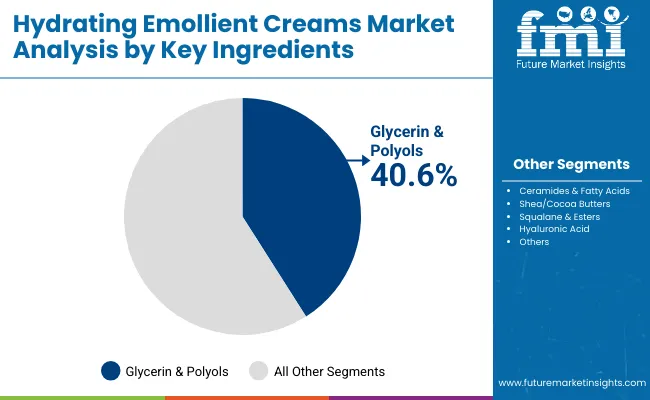
| Key Ingredients | Value Share % 2025 |
|---|---|
| Glycerin & polyols | 40.6% |
| Others | 59.4% |
The ceramides and fatty acids segment is forecasted to hold 59.4% of the market share in 2025, driven by its critical role in strengthening the skin’s lipid barrier and preventing transepidermal water loss. These ingredients are increasingly incorporated in formulations for chronic dryness, xerosis, and sensitive skin, due to their ability to mimic the skin’s natural composition.
The segment’s expansion is bolstered by the rise of dermocosmetic brands emphasizing clinical-grade hydration and pharmacy-based moisturizers formulated with lipid-repair complexes. As consumer awareness of skin barrier science continues to rise, ceramides and fatty acids are expected to sustain their leadership through both mass-market and premium product ranges.
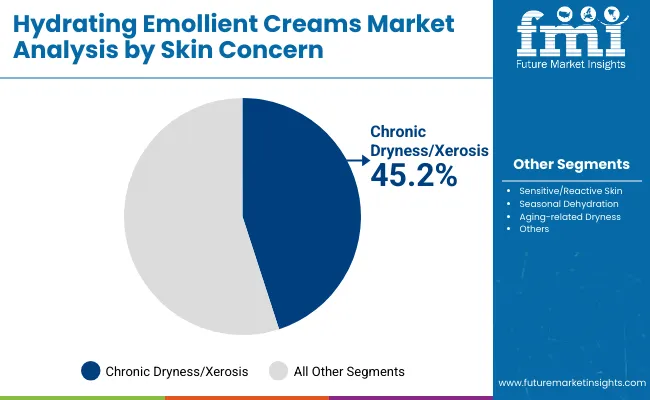
| Skin Concern | Value Share % 2025 |
|---|---|
| Chronic dryness/ xerosis | 45.2% |
| Others | 54.8% |
The chronic dryness/xerosis segment is projected to account for 45.2% of the Hydrating Emollient Creams Market revenue in 2025, establishing it as the leading application category. This dominance stems from the increasing prevalence of skin dehydration caused by climate fluctuations, pollution, and aging. Formulations targeting xerosis often contain glycerin, hyaluronic acid, and ceramide-rich emulsions that deliver deep, lasting hydration.
Pharmaceutical and dermocosmetic players are investing in clinically validated solutions for sensitive and atopic-prone skin, further fueling demand. Given its alignment with rising medical skincare trends and consumer emphasis on barrier repair, chronic dryness/xerosis is expected to maintain its leading role throughout the forecast period.
Rising Prevalence of Skin Dryness and Sensitivity
The growing incidence of skin dryness, sensitivity, and barrier dysfunction due to pollution, aging, and increased exposure to digital blue light has significantly boosted demand for hydrating emollient creams. Consumers are shifting toward clinically validated products that restore the skin’s lipid barrier and maintain hydration balance.
Brands are responding by formulating creams enriched with ceramides, fatty acids, and polyols. The rise of dermatologically tested and hypoallergenic formulations, particularly in pharmacy and dermocosmetic channels, continues to drive consistent market expansion across all age and skin-type categories.
Expansion of E-commerce and Direct-to-Consumer (D2C) Channels
Digital retail growth has transformed access to premium and personalized skincare solutions. E-commerce platforms enable consumers to explore and purchase emollient creams tailored to their skin concerns through AI-driven recommendations and subscription models. Leading brands such as CeraVe, Eucerin, and The Ordinary leverage digital campaigns emphasizing clinical efficacy, transparency, and sustainability.
This shift toward online engagement has accelerated product awareness, particularly in Asia and Europe, where D2C strategies have expanded market reach. Consequently, online distribution is emerging as a critical driver, complementing pharmacy and specialty retail growth in this segment.
Ingredient Cost Volatility and Formulation Challenges
The market faces challenges linked to the high cost and limited availability of natural emollients such as squalane, plant butters, and bio-derived ceramides. Maintaining formulation stability while ensuring sensory appeal and efficacy adds complexity to product development.
Additionally, regulatory scrutiny over synthetic preservatives and silicones has increased formulation costs and extended approval timelines. These factors collectively restrict the entry of smaller brands and impact pricing flexibility. As consumers demand clean-label, vegan, and dermatologist-tested formulations, balancing cost-efficiency with performance and compliance remains a persistent restraint for manufacturers.
Growing Preference for Dermatologist-Endorsed and Barrier-Repair Formulations
A key trend shaping the Hydrating Emollient Creams Market is the surge in demand for clinically backed, dermatologist-endorsed products focusing on barrier repair and long-lasting hydration. Consumers increasingly associate scientific credibility with product safety and performance.
Brands are introducing advanced formulations featuring biomimetic lipids, ceramide complexes, and hyaluronic acid that target dryness, eczema, and sensitivity. The convergence of skincare and pharmaceutical research has also given rise to the dermocosmetic category, blurring the line between therapeutic and cosmetic care. This evidence-based trend continues to redefine product positioning and marketing narratives across global skincare markets.
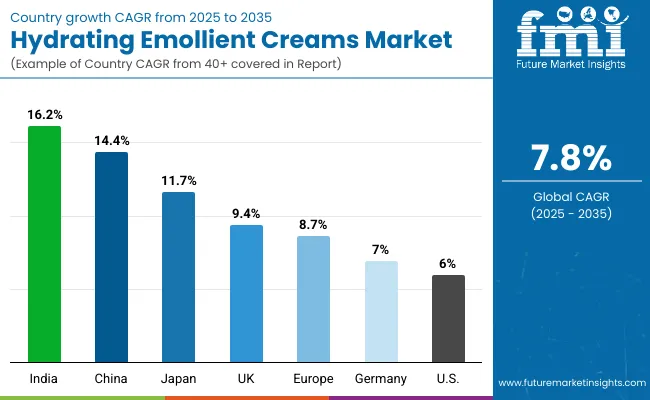
| Country | Estimated CAGR (2025 to 2035) |
|---|---|
| China | 14.4% |
| USA | 6.0% |
| India | 16.2% |
| UK | 9.4% |
| Germany | 7.0% |
| Japan | 11.7% |
The global Hydrating Emollient Creams Market exhibits strong regional variation in growth, shaped by differences in climate, skincare routines, income levels, and distribution channel maturity. Asia-Pacific leads the expansion, anchored by India (16.2% CAGR) and China (14.4% CAGR).
India’s trajectory is supported by rising disposable income, increasing awareness of skincare health, and widespread adoption of affordable daily hydrating creams among both men and women. China’s market expansion is driven by the premiumization trend, a surge in dermocosmetic and K-beauty-inspired formulations, and the dominance of e-commerce and pharmacy retail networks. Consumers increasingly favor creams infused with ceramides, hyaluronic acid, and squalane for hydration under varying climatic conditions.
Japan follows with an 11.7% CAGR, driven by its aging population and the high demand for anti-aging and skin-barrier-repair creams that combine hydration with wrinkle-care benefits. Japanese brands focus heavily on clinical-grade emulsions with biomimetic actives, contributing to the region’s reputation for high-performance skincare.
In Europe, the market demonstrates stable growth led by the UK (9.4%) and Germany (7.0%), supported by the popularity of pharmacy-led brands like CeraVe, Eucerin, and Weleda. Regulatory support for dermatologically tested and vegan-certified moisturizers strengthens the region’s premium segment.
North America, particularly the USA (6.0%), shows moderate growth due to market maturity but remains a hub for innovation, ingredient transparency, and clinical validation. Growth here is largely driven by digital-native skincare brands, subscription-based D2C models, and consumer interest in barrier-repair and sensitive-skin formulations.
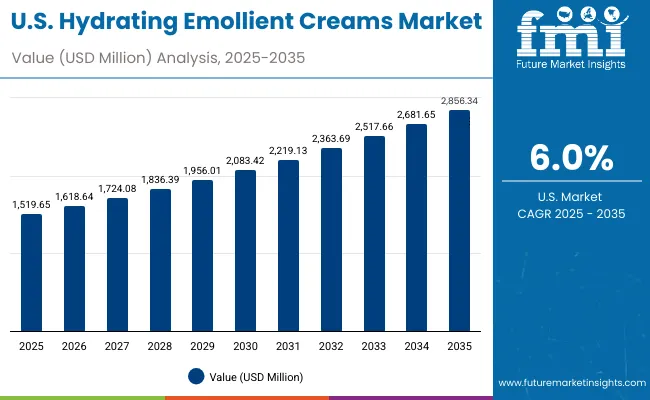
| Year | USA Hydrating Emollient Creams Market (USD Million) |
|---|---|
| 2025 | 1519.65 |
| 2026 | 1618.64 |
| 2027 | 1724.08 |
| 2028 | 1836.39 |
| 2029 | 1956.01 |
| 2030 | 2083.42 |
| 2031 | 2219.13 |
| 2032 | 2363.69 |
| 2033 | 2517.66 |
| 2034 | 2681.65 |
| 2035 | 2856.34 |
The Hydrating Emollient Creams Market in the United States is projected to grow at a CAGR of 6.0%, supported by rising demand for dermatologist-endorsed, fragrance-free formulations and a consumer shift toward functional hydration with clinical efficacy.
The segment benefits from expanding pharmacy distribution, brand diversification, and an increasing preference for clean-label and non-comedogenic creams. Online retail and subscription-based skincare models are reshaping purchase patterns, with younger consumers seeking personalized routines supported by AI-driven skin diagnostics.
The Hydrating Emollient Creams Market in the United Kingdom is projected to grow at a CAGR of 9.4%, supported by rising consumer preference for dermatologist-endorsed skincare, expansion of pharmacy-led retail, and increasing awareness of skin barrier health.
British consumers are adopting fragrance-free and hypoallergenic formulations, especially those targeting dryness from cold weather and indoor heating exposure. The growth of vegan, cruelty-free, and refillable packaging has aligned with sustainability-conscious consumer behavior. Additionally, collaborations between dermatologists and beauty influencers have increased brand credibility and product trials.
India is witnessing rapid growth in the Hydrating Emollient Creams Market, which is forecast to expand at a CAGR of 16.2% through 2035. Demand is driven by rising disposable income, skincare education through social media, and increased dermatology consultations among urban and semi-urban consumers.
Local manufacturers are launching affordable, climate-adaptive daily hydrating creams designed for humid and dry regions alike. The growing prevalence of xerosis, pigmentation, and post-sun dryness has fueled the use of glycerin, shea butter, and hyaluronic acid-based formulas. Expansion of pharmacy chains and e-commerce platforms is ensuring better reach across tier-2 and tier-3 cities.
The Hydrating Emollient Creams Market in China is expected to grow at a CAGR of 14.4%, the highest among major economies. Growth is propelled by strong consumer demand for moisture-rich and brightening creams, extensive cross-border e-commerce, and the popularity of K-beauty and J-beauty influences.
Chinese consumers favor multi-functional emollient creams combining hydration, tone correction, and anti-aging benefits. Domestic skincare brands are investing in biomimetic lipid systems and hyaluronic acid complexes, while international brands continue to lead in the premium segment. Government emphasis on cosmetic safety standards and digital marketing innovations are further fueling market expansion.
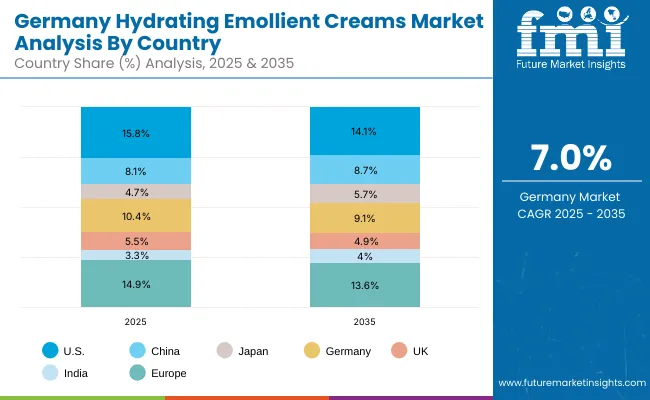
| Country | 2025 Share (%) |
|---|---|
| USA | 15.8% |
| China | 8.1% |
| Japan | 4.7% |
| Germany | 10.4% |
| UK | 5.5% |
| India | 3.3% |
| Country | 2035 Share (%) |
|---|---|
| USA | 14.1% |
| China | 8.7% |
| Japan | 5.7% |
| Germany | 9.1% |
| UK | 4.9% |
| India | 4.0% |
The Hydrating Emollient Creams Market in Germany is projected to grow at a CAGR of 7.0%, sustained by its position as one of Europe’s leading skincare and cosmetic manufacturing hubs. German consumers exhibit a strong preference for dermatologist-tested and pharmacy-grade emollients, emphasizing formulations that are fragrance-free, hypoallergenic, and clinically validated.
Brands such as Eucerin and Weleda have shaped the country’s skincare standards through innovations in barrier-repair technology and bio-based actives. The market is also seeing increased adoption of vegan and sustainability-certified moisturizers, reflecting the wider European Union emphasis on eco-friendly labeling and reduced packaging waste.
Pharmacy channels continue to dominate sales, while D2C online platforms are emerging as complementary growth drivers, offering customized recommendations and subscription refills. The shift toward sensitive-skin and aging-related dryness treatments has created opportunities for creams infused with ceramides, fatty acids, and hyaluronic acid. With an aging population and growing consumer interest in medical skincare, Germany remains a cornerstone market for clinical emollient formulations.
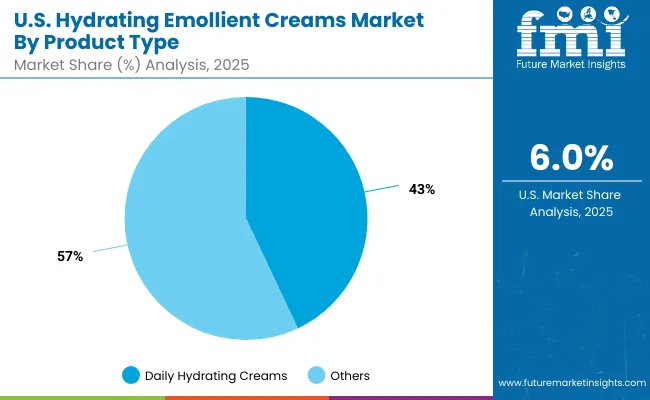
| USA By Product Type | Value Share % 2025 |
|---|---|
| Daily hydrating creams | 43.1% |
| Others | 56.9% |
The Hydrating Emollient Creams Market in the United States is expected to expand steadily at a CAGR of 6.0%. Growth is driven by heightened awareness of skin barrier health, propelled by social media and dermatologist-endorsed education campaigns.
Consumers increasingly prefer fragrance-free, paraben-free, and non-comedogenic formulations that target both dryness and irritation. Mass-market and pharmacy brands such as CeraVe, Cetaphil, and Aveeno dominate the segment, while emerging D2C players are innovating with AI-based personalization and subscription-driven skincare models. Online platforms, dermatology clinics, and major pharmacy chains are converging to strengthen multi-channel access.
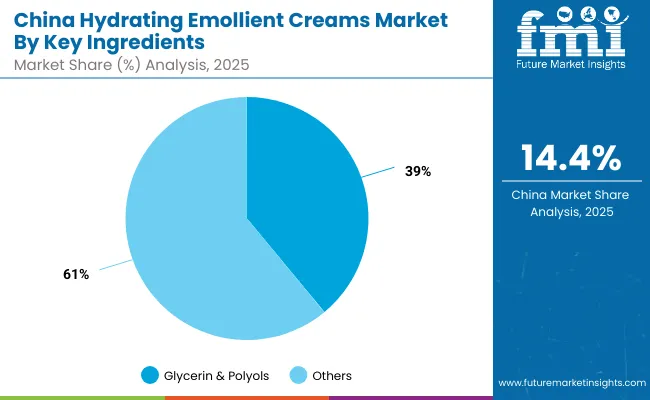
| China By Key Ingredients | Value Share % 2025 |
|---|---|
| Glycerin & polyols | 38.8% |
| Others | 61.2% |
The Hydrating Emollient Creams Market in China is expected to grow at a CAGR of 14.4%, the highest among all major countries. This rapid expansion is supported by the rise of premium skincare brands, cross-border e-commerce, and domestic innovation in ceramide-based formulations.
Urban consumers are prioritizing hydration and skin-brightening benefits, with strong traction for products featuring hyaluronic acid, polyols, and botanical lipids. Domestic players are competing aggressively with multinational brands by offering high-performance yet affordable emollient creams, tailored to local skin types and humidity conditions. Government-backed policies encouraging clean-label and safety-certified cosmetics further strengthen consumer trust.
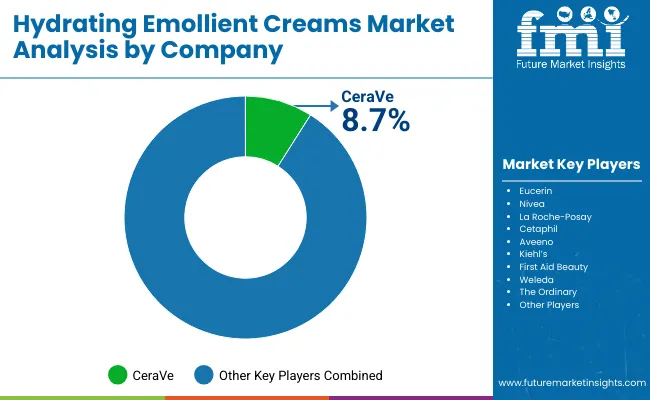
| Company | Global Value Share 2025 |
|---|---|
| CeraVe | 8.7% |
| Others | 91.3% |
The Hydrating Emollient Creams Market is moderately fragmented, with a mix of global skincare leaders, dermocosmetic specialists, and emerging digital-native brands competing across multiple price and formulation tiers. Global leaders such as CeraVe, Eucerin, and Nivea hold a substantial market share due to their dermatologist-endorsed formulations, strong pharmacy distribution networks, and investments in clinical research. Their strategies focus on barrier-repair technology, ceramide and hyaluronic acid complexes, and skin microbiome balance, positioning them as trusted solutions for chronic dryness and sensitive skin.
Established mid-tier brands including La Roche-Posay, Cetaphil, and Aveeno are expanding through product diversification and regional partnerships with healthcare professionals. These players are accelerating adoption via digital skincare consultations, AI-driven skin diagnostics, and targeted marketing campaigns, ensuring relevance across both clinical and retail skincare ecosystems.
Emerging and niche brands such as Kiehl’s, First Aid Beauty, Weleda, and The Ordinary are reshaping consumer perception through clean-label formulations, sustainable packaging, and transparency in ingredient sourcing. Their agility in responding to evolving consumer preferencesparticularly among younger, ingredient-conscious audiencesprovides a competitive edge.
Competitive differentiation in this market is shifting away from mass branding toward science-backed efficacy, sustainability credentials, and personalization. Companies integrating AI-based skin mapping, eco-certified ingredients, and D2C subscription models are redefining growth opportunities. The future landscape will favor brands that build integrated skincare ecosystems offering long-term hydration, barrier protection, and ethical product innovation.
Key Developments in Hydrating Emollient Creams Market
| Item | Value |
|---|---|
| Quantitative Units | USD 9,601.3 Million |
| Product Type | Rich barrier creams, Daily hydrating creams, Dermocosmetic repair balms, Overnight moisture masks |
| Key Ingredients | Glycerin & polyols, Ceramides & fatty acids, Shea /cocoa butters, Squalane & esters, Hyaluronic acid |
| Skin Concern | Chronic dryness/ xerosis, Sensitive/reactive skin, Seasonal dehydration, Aging-related dryness |
| Channel | Pharmacies & drugstores, E-commerce, Supermarkets & hypermarkets, Specialty beauty retail |
| End User | Women, Men, Unisex family care, Senior skin |
| Regions Covered | North America, Europe, Asia-Pacific, Latin America, Middle East & Africa |
| Country Covered | United States, Canada, Germany, France, United Kingdom, China, Japan, India, Brazil, South Africa |
| Key Companies Profiled | CeraVe, Eucerin, Nivea, La Roche- Posay, Cetaphil, Aveeno, Kiehl’s, First Aid Beauty, Weleda, The Ordinary |
| Additional Attributes | Dollar sales by product type and skin concern, adoption trends in dermatology and pharmacy-based skincare, rising demand for daily hydrating and barrier-repair creams, segment-specific growth in sensitive-skin and anti-aging categories, ingredient-based revenue segmentation led by ceramides, fatty acids, and hyaluronic acid complexes, integration of AI-driven skin diagnostics and personalized hydration platforms, regional trends influenced by e-commerce expansion and premium dermocosmetic adoption, and continuous innovations in bio-based emollients, lipid encapsulation, and microbiome-safe formulation technologies. |
The global Hydrating Emollient Creams Market is estimated to be valued at USD 9,601.3 million in 2025.
The market size for the Hydrating Emollient Creams Market is projected to reach USD 20,302.4 million by 2035.
The Hydrating Emollient Creams Market is expected to grow at a 7.8% CAGR between 2025 and 2035.
The key product types in the Hydrating Emollient Creams Market are rich barrier creams, daily hydrating creams, dermocosmetic repair balms, and overnight moisture masks.
In terms of formulation preference, the daily hydrating creams segment is expected to command a 41.6% share of the Hydrating Emollient Creams Market in 2025, driven by widespread consumer adoption for everyday moisturization and skin barrier maintenance.






Our Research Products

The "Full Research Suite" delivers actionable market intel, deep dives on markets or technologies, so clients act faster, cut risk, and unlock growth.

The Leaderboard benchmarks and ranks top vendors, classifying them as Established Leaders, Leading Challengers, or Disruptors & Challengers.

Locates where complements amplify value and substitutes erode it, forecasting net impact by horizon

We deliver granular, decision-grade intel: market sizing, 5-year forecasts, pricing, adoption, usage, revenue, and operational KPIs—plus competitor tracking, regulation, and value chains—across 60 countries broadly.

Spot the shifts before they hit your P&L. We track inflection points, adoption curves, pricing moves, and ecosystem plays to show where demand is heading, why it is changing, and what to do next across high-growth markets and disruptive tech

Real-time reads of user behavior. We track shifting priorities, perceptions of today’s and next-gen services, and provider experience, then pace how fast tech moves from trial to adoption, blending buyer, consumer, and channel inputs with social signals (#WhySwitch, #UX).

Partner with our analyst team to build a custom report designed around your business priorities. From analysing market trends to assessing competitors or crafting bespoke datasets, we tailor insights to your needs.
Supplier Intelligence
Discovery & Profiling
Capacity & Footprint
Performance & Risk
Compliance & Governance
Commercial Readiness
Who Supplies Whom
Scorecards & Shortlists
Playbooks & Docs
Category Intelligence
Definition & Scope
Demand & Use Cases
Cost Drivers
Market Structure
Supply Chain Map
Trade & Policy
Operating Norms
Deliverables
Buyer Intelligence
Account Basics
Spend & Scope
Procurement Model
Vendor Requirements
Terms & Policies
Entry Strategy
Pain Points & Triggers
Outputs
Pricing Analysis
Benchmarks
Trends
Should-Cost
Indexation
Landed Cost
Commercial Terms
Deliverables
Brand Analysis
Positioning & Value Prop
Share & Presence
Customer Evidence
Go-to-Market
Digital & Reputation
Compliance & Trust
KPIs & Gaps
Outputs
Full Research Suite comprises of:
Market outlook & trends analysis
Interviews & case studies
Strategic recommendations
Vendor profiles & capabilities analysis
5-year forecasts
8 regions and 60+ country-level data splits
Market segment data splits
12 months of continuous data updates
DELIVERED AS:
PDF EXCEL ONLINE
Emollients Market Analysis - Size and Share Forecast Outlook 2025 to 2035
Emollients in Personal Care Market Analysis - Size, Share, and Forecast Outlook 2025 to 2035
Global Hydrating Spray Market Size and Share Forecast Outlook 2025 to 2035
Emollient Esters Market
Dehydrating Breather Market Size and Share Forecast Outlook 2025 to 2035
Smart Hydrating Skin Gels Market Size and Share Forecast Outlook 2025 to 2035
Firming Creams and Serums Market Analysis - Size and Share Forecast Outlook 2025 to 2035
Slugging Creams Market Size and Share Forecast Outlook 2025 to 2035
Anti-Aging Creams & Serums Market Size and Share Forecast Outlook 2025 to 2035
Algae-Based Emollients Market Analysis - Size and Share Forecast Outlook 2025 to 2035
Anti-Wrinkle Creams Market Size and Share Forecast Outlook 2025 to 2035
Body Firming Creams Market Growth & Forecast 2025-2035
Eczema Relief Creams Market Analysis - Size and Share Forecast Outlook 2025 to 2035
Muscle Relaxing Creams Market Size and Share Forecast Outlook 2025 to 2035
Plant-Based Ice Creams Market Analysis by Form, Product Type, Flavor, Source, Sales Channel, and Region through 2035
Moisturizing Body Creams Market Size and Share Forecast Outlook 2025 to 2035
Age-Defying Night Creams Market Analysis - Size and Share Forecast Outlook 2025 to 2035
Probiotic-Infused Creams Market Size and Share Forecast Outlook 2025 to 2035
Cica-Infused Healing Creams Market Analysis - Size, Share, and Forecast Outlook 2025 to 2035
Vitamin E Antioxidant Creams Market Analysis - Size, Share, and Forecast Outlook 2025 to 2035

Thank you!
You will receive an email from our Business Development Manager. Please be sure to check your SPAM/JUNK folder too.
Chat With
MaRIA